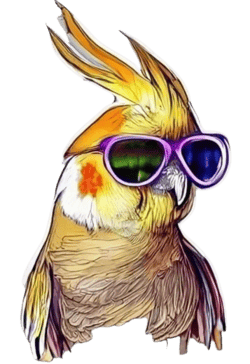Discerning Dilemma: Practical Tips on How to Tell if My Cockatiel is Male or Female
Introduction
A. Quick Overview of Cockatiels
Cockatiels are playful, affectionate and intelligent birds that hail from the arid regions of Australia. Characterized by their bright orange cheeks and large, expressive crests, these feathered charmers have successfully made their way into the hearts and homes of bird lovers across the globe.
B. Importance of Knowing Your Cockatiel’s Gender
Determining your bird’s gender is more than a point of curiosity. Male and female cockatiels often show differences in behaviour, health and care needs. Knowing your bird’s gender can help you understand their individual needs and adjust your care accordingly.
C. An Overview of the Article’s Content
In this post, we’ll explore various ways in which you can determine the gender of your cockatiel, from observing physical characteristics and behaviour to seeking professional advice. So, let’s dive in and get to the feather-bottom of this feathery mystery!
Basic Understanding of Cockatiel Gender

A. Biological Differences between Male and Female Cockatiels
On the outside, male and female cockatiels look almost similar. However, there are certain subtle physical characteristics and behaviours that differentiate the two.
B. Limitations of Early Age Gender Determination
Sexing cockatiels by appearance alone can be challenging till they get their first molt, around six to nine months of age. Before this, male and female chicks often look alike.
C. The Right Time for Accurate Gender Determination
Typically, cockatiels reach sexual maturity between 6-12 months. It’s the ideal time when physical differences become more noticeable.
Visual Characteristics: How to Tell if My Cockatiel is Male or Female
A. Colouration and Markings
Male cockatiels usually have more vibrant colours than their female counterparts, with brighter yellow faces and more pronounced orange cheek patches.
B. Size and Shape of a Cockatiel
Generally, females tend to be slightly smaller with less rounded heads compared to males.
C. Feather Patterns and Eye colour for understanding How to Tell if My Cockatiel is Male or Female
Under-tail feather patterns can be a giveaway. Males generally have solid coloured feathers, while females sport a series of spots or stripes. Eye colour can also be a clue. Males often have darker, more rounded eyes.
Behavioural Traits: How Male and Female Cockatiels Act

A. Interaction with Other Birds
Males are typically more active and social, while females are quieter and tend to keep to themselves.
B. Vocalizing and Singing Behaviours
Is your bird a natural performer? Males are known for their complex songs and melodies, while females tend to stick to basic chirps and whistles.
C. Nesting and Mating Habits
Females display nesting behaviours such as sitting in one spot for long periods or shredding paper. Males, on the other hand, do a lot of courting, displaying behaviours like head bobbing and ‘heart wings.’
Scientific Methods: Vet Advice and DNA Testing
A. Veterinary Inspection and Examination
Sometimes, visual cues and behavioural characteristics aren’t definitive. In such cases, a vet can help you get a more accurate determination.
B. DNA Testing for Precise Determination
For the most accurate results, DNA testing may be the answer. This involves collecting feathers, blood or eggshell samples for lab analysis.
C. Pros and Cons of DNA Testing
While DNA testing is accurate and non-invasive, it can be time-consuming and a little costly. Plus, it might be a bit of a hassle if the nearest avian vet is miles away.
Conclusion: The Importance of Understanding Your Cockatiel
A. Managing Expectations of Cockatiel Habits
Knowing your cockatiel’s gender not only helps mould your care routine but also lets you manage your expectations about their behaviour.
B. Bonding Better with Your Cockatiel
It can also bring you closer to your feathered friend, enhancing your bonding time together.
C. Ensuring Your Cockatiel’s Health and Wellness
Gender-specific health concerns can be better addressed when you know your cockatiel’s gender. This helps to ensure a happy and healthy life.
Frequently Asked Questions
A. How long does it take to discern my cockatiel’s gender?
Most physical and behavioural signs become apparent after six months of age. But for a more accurate determination, a vet consult or DNA testing may be needed.
B. What are common misconceptions about cockatiel gender determination?
Common myths include the belief that only males can whistle or that females cannot imitate sounds. Though these behaviours are more common in males, females can exhibit them too.
C. What if my cockatiel displays behaviour traits of both genders?
Birds can indeed exhibit behaviours of both genders. If it’s causing confusion, consider seeking professional help for accurate gender determination.
Summary
A. Recap of Key Points
To sum up, determining your cockatiel’s gender can involve checking physical traits, observing behavioural signs, and potentially seeking professional advice or DNA testing.
B. Importance Reiteration
Remember, knowing your bird’s gender can enhance your understanding of their traits, behaviour and health needs, thereby improving your bond with them.
C. Encouragement for Ongoing Learning and Observation
Keep observing and learning about your charming cockatiel. The more you understand about them, the more fulfilling your feathery friendship will be. Happy bird-watching!
If you’re gearing up for the holiday season and wondering about the safety of Christmas trees for your cockatiel, check out our guide on “Are Christmas Trees Safe for Cockatiels?” It provides valuable insights into potential risks and precautions to ensure a safe and joyful festive season for both you and your feathered friend. Happy bird-watching!

About Me
I’m Kamran, a co-founder and content creator at cockatielhq.com. With 8+ years in the world of avian enthusiasts, I’ve gained extensive knowledge in caring for birds. From egg-laying and mating to cohabitation with other birds, dietary needs, nurturing, and breeding, I’m here at cockatielhq.com to share valuable insights for your avian companions.







